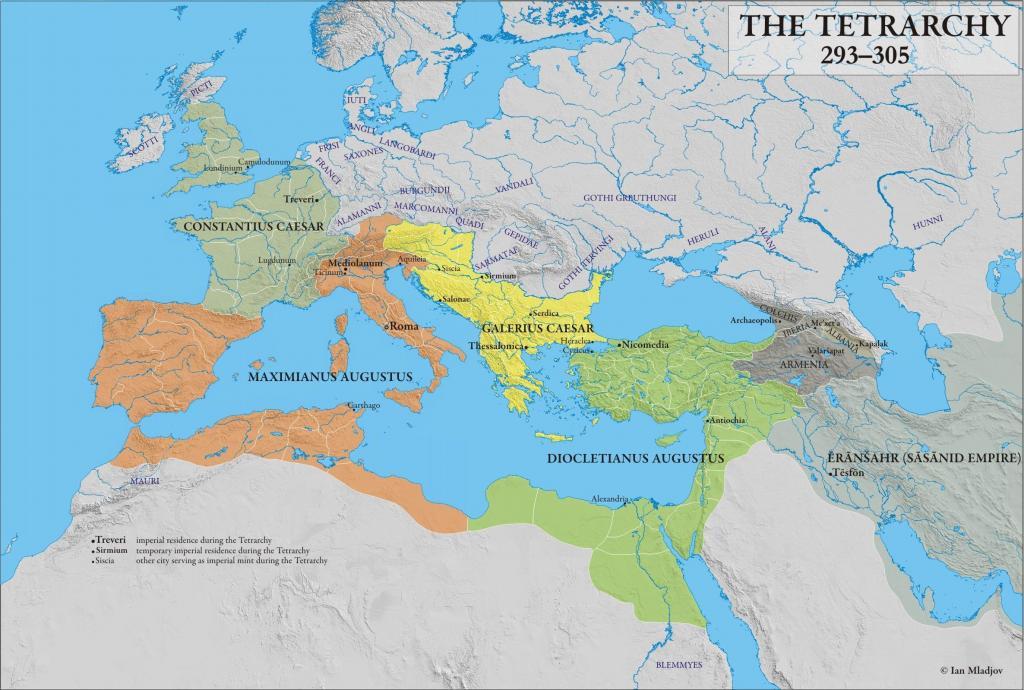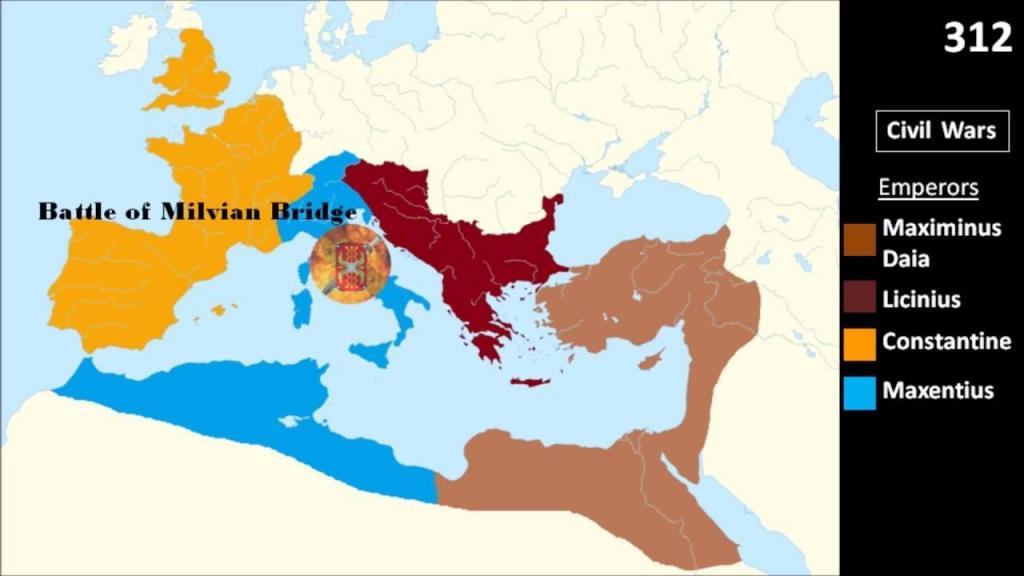Constantine the Great was one of the most important figures in both Roman and Christian history. In the first part of this article, you can find the details about Constantine’s being the sole ruler in Rome. In the second part, you can see interesting facts about Emperor Constantine.
Life History of Emperor Constantine
Emperor Constantine was born at a time when the Roman Empire was in great political turmoil. The rise of Rome, which started with Augustus, was over. The emperors were deposed one after another, and the new ruler could not remain in power for more than a few years.
The period of chaos ended with Diocletian’s ascension to the throne. Diocletian made economic, social and military reforms to stop the decline in the Roman Empire.
Diocletian’s reforms introduced a new system of government called Tetrarchy. According to this system, there would be two senior (Augustus) and two junior emperors (Caesar) in the empire. High-level emperors were to direct politics, while lower-level emperors would conduct military operations.
1. Constantine’s Father Constantius
As can be seen on the map, the emperors of the WEST were Maximian “Augustus” and Constantius “Caesar”, and the emperors of the EAST were Diocletian “Augustus” and Galerius “Caesar”.
According to this new system, in which Diocletian set the rules, the emperors would retire after 20 years. At the end of 20 years, Diocletian retreated to his palace in Split, Croatia, and forced his co-emperor, Maximian, to retire. Thus Constantine’s father, Constantius, was promoted.
Constantius, the junior emperor (caesar) in Western Rome, was entitled to become a senior emperor with the title “Augustus”. Constantius, known as “the conqueror of Britain”, was raised on the shields of his soldiers and became the ruler of Europe.
However, Constantius’ reign lasted only one year. When Constantius died unexpectedly, the legions named his son Constantine as the new emperor. The proclamation of Constantine as the new emperor was not only due to his father. The legions were convinced of his leadership.
2. Constantine Becomes “Caesar”
Galerius, Diocletian’s successor, was the most senior emperor of the time. Galerius refused to accept the fait accompli of the Western army and declared that he would only recognize Constantine as “Caesar”. Thus Constantine becomes “Caesar”, the junior emperor of the West. Valerius Severus, a friend of Galerius, was appointed senior.
The system of tetrarchy was actually against human nature. Nobody intended to divide power into equal parts and live in peace. The fifty-year period of chaos in Rome had paused with the prosperity of Diocletian, but after his retirement the clashes resumed.
Constantine was the youngest and junior leader among the four emperors, but over time seized power alone. Alliances and conflicts during the period of tetrarchy were quite complicated. If you want more detailed information about it, you can read another article I wrote, called The Roman Tetrarchy.
3. Battle of the Milvian Bridge
Constantine had to wage many wars to end the tetrarchy and to become the leader alone. The most famous of these battles was the Battle of the Milvian Bridge. Constantine fought for the domination of Italy against a usurper named Maxentius. The night before the war, Jesus appears to Constantine in his dream and tells him that if he signs a cross on the shields of his soldiers, he will win the war.
According to the first narrative, Jesus told Constantine “In This Sign, You Will Conquer”. Then Constantine did as he was told and won the war with this talisman. According to the second narrative, a cross appeared in the sky during the war and the battle was won by divine intervention.
If Constantine, who had a tendency to Christianity, lost this war, the course of history would have changed. Because Maxentius, like many Roman emperors in the past, was pagan. The persecution of Christians for hundreds of years would probably continue. This war changed the course of history. However it was not enough to make Constantine the sole ruler of Rome. There were still other steps to be taken.
4. Edict of Milan by Emperor Constantine
Constantine, who won the Battle of the Milvian Bridge, had dominated much of Europe. In 313, he issued the Edict of Milan, bringing freedom of worship to Christians. He made an alliance with Licinius and led to the destruction of their common enemies, Maximinus Daia.
5. Battle of Chrysopolis
After the collapse of the Tetrarchy, only two emperors remained. Constantine fought with his rival Licinius within the borders of today’s Istanbul. Licinius, who defended in the ancient Greek city of Byzantium, then moved to the Asian side and fought Constantine in Chrysopolis (Uskudar). Battle of Chrysopolis is considered one of the 10 most important battles in the history of the Roman Empire.
6. Constantinople
One of the most important consequences of the Battle of Chrysopolis was that Emperor Constantine discovered the importance of Byzantium. Byzantium, founded as a Greek colony in 660 BC, had been under Roman domination since Septimus Severus’ reign.
Constantine, who had won the civil wars of the Tetrarchy, decided to move the capital to the East. He chose Byzantium as the new capital, which had a natural defense system against barbarian attacks.
Constantine’s dozens of architects and engineers sent to Byzantium to rebuild the city in six years. Byzantium was opened in 330 AD with the name of “New Rome”. The iconic structures of the city during the Constantine period were the Great Palace, the Church of the Holy Apostles and the Forum of Constantine.
New Rome was later called Constantinople in honor of its founder. Constantine, who lived the rest of his life in today’s Istanbul, was buried in the Church of the Holy Apostles when he died.
7. The First Council of Nicaea
Constantine was the first person laying the foundations of Christianity in political terms. The First Council of Nicaea was convened by Constantine in 325 AD and the principles of Christianity was decided upon.
After the Nicene Creed, Patriarchs were assigned to some important cities and Pentarchy (Five Major Episcopal Sees) became the leading religious centers of Christianity. These cities were Rome, Constantinople, Antioch, Jerusalem and Alexandria.
During the Middle Ages, the leader of the Western Church was “Pope” in Rome and leader of the Eastern Church was “Patriarch” in Istanbul. Rivalry between them went on for centuries. It eventually caused the Great Schism in 1054, the separation of two churches.
8. Byzantine Empire
Constantine’s moving the capital to the East extended the life of the Roman Empire for another thousand years. The eastern half of Rome, which carried an ancient Greek heritage, survived until 1453. Yet the Western Roman Empire collapsed due to barbarian attacks in 476 AD.
The Eastern Roman Empire inherited the military, political and architectural heritage of ancient Rome. Eastern Roman Empire is defined as the Byzantine Empire in modern history. For more information, I can recommend history of the Byzantine Empire.
Interesting Facts about Emperor Constantine
Emperor Constantine shaped the history of Europe with his decisions and wars. However, despite being such a famous person, there are many unknowns about him. In the following lines you can find interesting facts about Emperor Constantine.
1. Constantine Escaped from Galerius’ Palace
The emperors in the Tetrarchy system entrusted their children to each other. They gave their daughters to the family of the other emperor or entrusted their son until he grew up.
Constantine was the son of Constantius Chlorus, the Western emperor. However, he spent his childhood at the palace of the Eastern emperor Galerius in Nicomedia.
One day when Galerius was drunk, Constantine persuaded Galerius to let him leave the palace. So he could join his father’s army in Britain. He feared that Galerius would change his mind when he escaped the palace. He perished the horses of the palace guards so that no one could come after him.
2. Did Constantine really become a Christian?
Whether Constantine the Great was truly a Christian is one of the most controversial issues in history. According to some historians, Constantine recognized Christianity for political purposes. But the actions of Constantine after moving from Rome to Byzantium prove that he was a Christian.
3. Emperor Constantine and Christianity
Constantine expanded Hagia Eirene Church, which was the episcopacy center in Byzantium. Then he also built the Church of the Holy Apostles which was dedicated to 12 apostles of Jesus Christ.
According to some historians, the construction of “the first Hagia Sophia” was started by Constantine. However, whether this claim is true or not, Hagia Sophia was completed during the reign of Constantius II (the son of Constantine the Great).
Emperor Constantine supported his mother Helena on her pilgrimage to Jerusalem. As a result of this journey, the sacred relics of Christianity were brought to the new capital Constantinople. He placed some of these sacred relics on the basis of the column he erected in the Forum of Constantine.
It is, of course, controversial whether Constantine really buried the sacred relics at the base of the column. However, it is one of the beautiful legends that form the basis of the Byzantine History Tours I organize in Istanbul.
Emperor Constantine Facts by Serhat Engul




Thanks for this summarized account of emperor Constantine. My question is who did Constantine leave in charge of Rome (Western Europe) when he transferred to Byzantium? Thanks.
Dear Geoffrey Wandera, first of all thank you for your comment.
Constantine was the first emperor to become sole ruler after a long time. However, while still alive, he shared the authority with his sons. Constantius II, Constantine II and Constans were declared “Caesar”.
After their father died, they became “Augustus” and began to rule the state as three emperors. However, this did not last long and wars began between the brothers.
Italy (and Rome) were under Constans specifically. However, Constantine II ruled Spain, France and England. The East was under Constantius II. You can confirm this information from this map on Wikipedia.